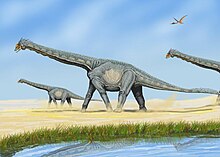Sauropod hiatus
The sauropod hiatus is a period in the North American fossil record for most of the
History of the concept
Definite evidence of Late Cretaceous sauropods in North America was first discovered in 1922, when
Background
Around the end of the
Beginning of the hiatus
The North American sauropod hiatus began during the
The species epithet of Sauroposeidon proteles means "perfected before the end" in reference to its status as one of the last North American sauropods before the sauropod hiatus.[11]
Possible causes

The cause of the sauropod hiatus has been a subject of debate. Lucas and Hunt proposed two hypotheses: a lack of properly preserved remains or a genuine extinction followed by re-population from South America.
In 2011, Philip D. Mannion and Paul Upchurch re-evaluated the sauropod hiatus, taking numerous factors into account. They argued that the event represented
However, in 2012, Michael D. D’Emic and Brady Z. Foreman countered the analysis of Mannion and Upchurch. They cited a recent cladistic analysis of
D'Emic and Foreman discussed multiple events that could have led to a regional extinction. In the late Albian, the
End of the hiatus

Whatever the cause of the sauropod hiatus, sauropods do not reappear in the North American fossil record until near the end of the Cretaceous. Various specimens have been claimed to represent Campanian records of sauropods in North America,
Alamosaurus probably reached North America by crossing over from South America.[19][20][21] Other studies have viewed the idea that Alamosaurus could have crossed over from South America skeptically, as the only connection between the Americas at the time may have been island chains that titanosaurs would have been poorly suited to cross, and proposed that Alamosaurus reached North America from Asia instead.[2] However, this hypothesis is based on studies that did not include Alamosaurus's South American close relative Pellegrinisaurus.[20] Sauropods have been considered poorly adapted for high-latitude environments, which would have made the Bering land bridge between Asia and North America inhospitable for titanosaurs.[21] The first appearance of hadrosaurs in South America coincides with the first appearance of titanosaurs in North America, suggesting that titanosaurs may have dispersed north along the same routes as hadrosaurs dispersed south.[15] It has also been proposed that Alamosaurus belongs to a lineage of titanosaurs native to North America,[17] but no other known North American sauropod is closely related to Alamosaurus, rendering such a possibility unlikely.[15]
Outside of North America
Though the "sauropod hiatus" originally referred to a North American absence of sauropods,[3] a similar trend has been noted in Europe, lasting from the late Coniacian to the Santonian. The European gap was discussed in a similar manner by Éric Buffetaut and Jean Le Loeuff in multiple 1990s studies.[2] Buffetaut and Loeuff suggested that this European hiatus reflected an extinction of sauropods in Europe, suggesting that new migrants eventually arrived from Africa.[2] Mannion and Upchurch could not prove an African birthplace for European titanosaurs, although they stated Southern Hemispheric ancestry for certain groups to be a possibility.[2] Due to the scarcity of fossil deposits from the European sauropod hiatus, Le Loeuff considered the existence of such a hiatus tentative.[22] Trackways and a sauropod tooth have been found in Europe during the supposed hiatus, suggesting that sauropods were present in Europe throughout the Late Cretaceous, though their fossils are very rare.[23][24]
See also
References
- ISSN 0096-8749.
- ^ ISSN 0031-0182. Retrieved 28 January 2023.
- ^ ISBN 0-8137-2238-1. Retrieved 28 January 2023.
- ^ S2CID 129439417.
- PMID 33203331.
- ISBN 0-520-24209-2.
- PMID 34150318.
- ^ S2CID 128486488. Retrieved 29 January 2023.
- ^ PMID 20179896.
- S2CID 133054430.
- S2CID 55987496.
- ISSN 0272-4634.
- S2CID 131258619.
- S2CID 129950838.
- ^ ISSN 0031-0182.
- ^ Ryan, Michael J.; Evans, David C. (2018). "The first occurrence of a sauropod body fossil in Canada, with implications for the "sauropod hiatus" in North America" (PDF). Journal of Vertebrate Paleontology. 38: 207.
- ^ ISBN 0-253-33907-3.
- ^ Dalman, Sebastian G.; Loewen, Mark A.; Pryon, R. Alexander; Jasinski, Steven A.; Malinzak, D. Edward; Lucas, Spencer G.; Fiorillo, Anthony R.; Currie, Phillip J.; Longrich, Nicholas R. "A giant tyrannosaurfrom the Campanian–Maastrichtian of southern North America and the evolution of tyrannosaurid gigantism". Scientific Reports. 14 (22124): 9.
- PMID 27048465.
- ^ ISSN 0195-6671.
- ^ S2CID 245273901.
- ISSN 0253-6730.
- PMID 28607394.
- S2CID 225242138.
